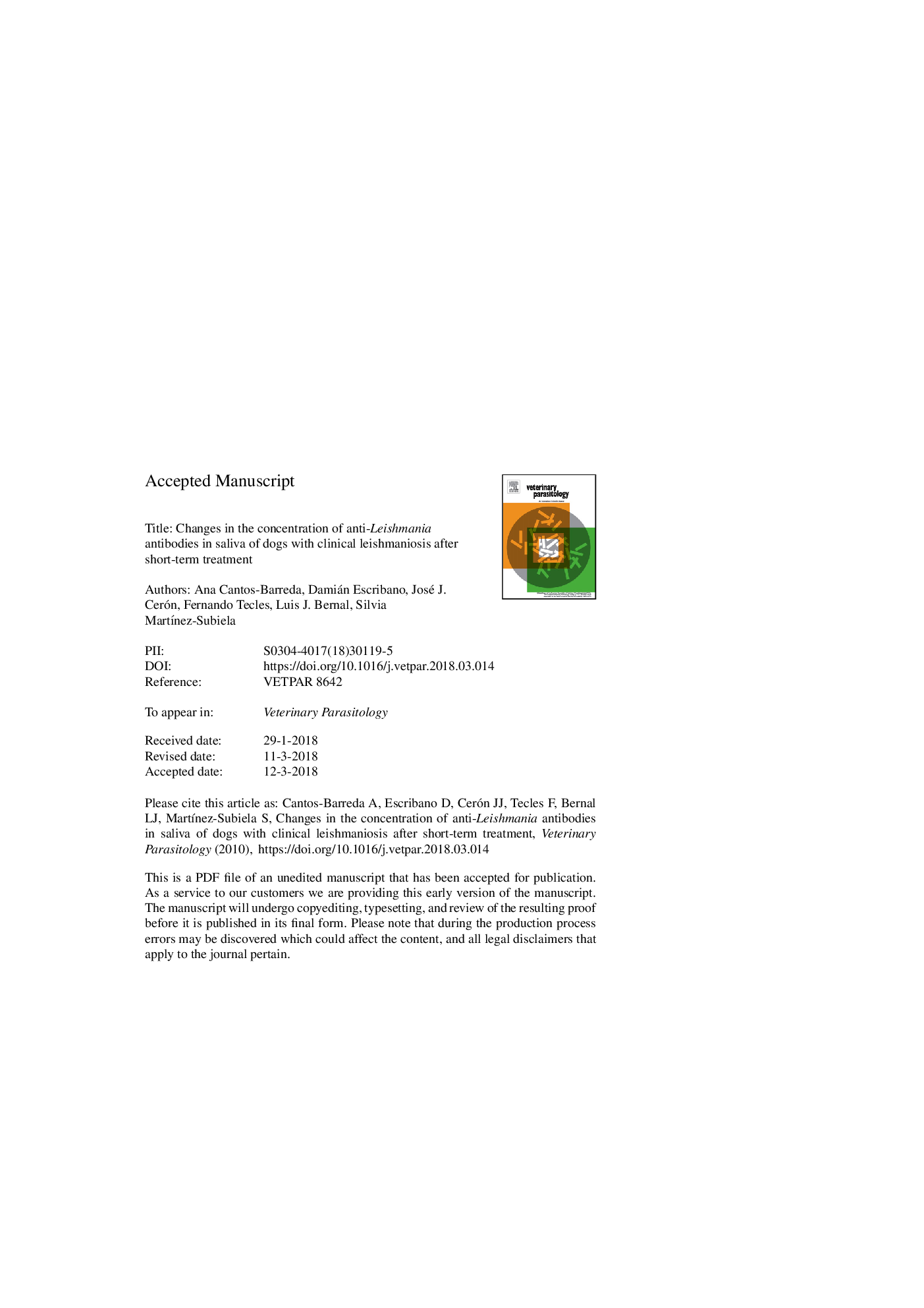| کد مقاله | کد نشریه | سال انتشار | مقاله انگلیسی | نسخه تمام متن |
|---|---|---|---|---|
| 8506037 | 1555622 | 2018 | 30 صفحه PDF | دانلود رایگان |
عنوان انگلیسی مقاله ISI
Changes in the concentration of anti-Leishmania antibodies in saliva of dogs with clinical leishmaniosis after short-term treatment
ترجمه فارسی عنوان
تغییرات غلظت آنتیبادی ضد لیشمانیا در بزاق سگ با لیشمانیوز بالینی پس از درمان کوتاه مدت
دانلود مقاله + سفارش ترجمه
دانلود مقاله ISI انگلیسی
رایگان برای ایرانیان
کلمات کلیدی
موضوعات مرتبط
علوم زیستی و بیوفناوری
علوم کشاورزی و بیولوژیک
علوم دامی و جانورشناسی
چکیده انگلیسی
The aim of this study was to evaluate the possible changes in the concentration of anti-Leishmania antibodies in saliva samples from dogs with clinical leishmaniosis after short-term treatment. Twenty dogs with clinical signs and laboratory abnormalities compatible with canine leishmaniosis (CanL) were diagnosed and treated with a standard antimonial plus allopurinol therapy. The concentration of anti-Leishmania IgG2 and IgA antibodies in saliva was measured at the time of diagnosis (day 0) and after treatment (day 30) by time-resolved immunofluorometric assays (TR-IFMAs) and results were compared with those of serum. In addition, correlations between antibody concentrations in saliva and serum, clinical scores and selected laboratory analytes were calculated. TR-IFMA results were expressed as Units of Fluorometry for Leishmania (UFL). Most dogs that adequately responded to treatment (nâ¯=â¯17) showed a reduction of anti-Leishmania antibodies in saliva [median IgG2: from 678.0 (day 0) to 201.1 UFL (day 30), pâ¯<â¯0.0001; median IgA: from 91.3 (day 0) to 60.2 UFL (day 30), pâ¯<â¯0.01] in accordance with clinical improvement (pâ¯<â¯0.0001). However, two of these dogs showed an increase of anti-Leishmania antibodies in saliva. Among dogs that did not improve after one month of treatment (nâ¯=â¯3), two showed a reduction in serum and saliva antibodies. In these two dogs, clinical recovery was achieved after one additional month of treatment with allopurinol. The other dog that did not respond to treatment showed increases in the concentration of anti-Leishmania antibodies, both in saliva and serum, and did not adequately respond to an additional month of treatment with allopurinol. From this pilot study, it could be concluded that, despite the low number of dogs used, the measurement of anti-Leishmania IgG2 and IgA antibodies in saliva could have a potential use for treatment monitoring of CanL, provided that a sufficient amount of specific antibodies is present at diagnosis. This is because, especially in the case of IgG2, there is a high correlation between the saliva and serum concentrations, and the reduction of antibodies is generally in accordance with the clinical improvement. Further long-term studies with a larger population should be undertaken to confirm this potential.
ناشر
Database: Elsevier - ScienceDirect (ساینس دایرکت)
Journal: Veterinary Parasitology - Volume 254, 30 April 2018, Pages 135-141
Journal: Veterinary Parasitology - Volume 254, 30 April 2018, Pages 135-141
نویسندگان
Ana Cantos-Barreda, Damián Escribano, José J. Cerón, Fernando Tecles, Luis J. Bernal, Silvia MartÃnez-Subiela,
